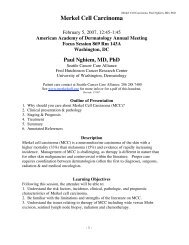Association of Merkel Cell Polyomavirus â Specific Antibodies With ...
Association of Merkel Cell Polyomavirus â Specific Antibodies With ...
Association of Merkel Cell Polyomavirus â Specific Antibodies With ...
You also want an ePaper? Increase the reach of your titles
YUMPU automatically turns print PDFs into web optimized ePapers that Google loves.
Figure 4 . Identification <strong>of</strong> amino acid residues<br />
in the major capsid protein (VP1) <strong>of</strong> <strong>Merkel</strong><br />
cell polyomavirus (MCPyV) 350 that confer low<br />
seroreactivity. A ) Alignment <strong>of</strong> VP1 sequences<br />
<strong>of</strong> three MCPyV strains and <strong>of</strong> the four other human<br />
polyomaviruses: BK virus (BKV), JC virus (JCV), KI<br />
polyomavirus (KIPyV), and WU polyomavirus<br />
(WUPyV). Sequences were obtained from GenBank<br />
and aligned with ClustalW ( http :// align . genome . jp / ).<br />
Sequences containing residues corresponding to<br />
the four divergent residues in the MCPyV VP1<br />
sequence are shown, with divergent residues<br />
boxed. Residue numbers refer to those in the<br />
MCPyV sequence. GenBank accession numbers for<br />
the VP1 sequences shown were FJ392560 for<br />
MCPyV w162, EU375803 for MCPyV 350, EU375804<br />
for MCPyV 339, NC_001538 for BKV, NC_001699 for<br />
JCV, EF127906 for KIPyV, and EF444549 for WUPyV.<br />
B ) Identification <strong>of</strong> VP1 residues essential for antibody<br />
recognition <strong>of</strong> MCPyV strain w162. Point mutations<br />
in the MCPyV 350 VP1 sequence and<br />
reactivity in plasma against the mutant proteins are<br />
shown. Point mutations at positions 288, 316, and<br />
366 were inserted in the MCPyV 350 VP1 sequence<br />
either alone or in combination by use <strong>of</strong> sitedirected<br />
mutagenesis. All mutant proteins were<br />
expressed as GST – VP1 fusion proteins in bacteria<br />
and tested in a multiplex antibody-binding assay<br />
with 28 plasma samples that had been shown to<br />
have reactivity against MCPyV w162 VP1 ( Figure 1 ).<br />
The letters listed vertically on the x -axis are the oneletter<br />
amino acid abbreviations for residues at the<br />
sequence position in the VP1 protein listed on the<br />
left. Letters that are white on a black background<br />
indicate that the sequence is the same as the<br />
MCPyV w162 VP1 sequence and letters that are<br />
black on a white background indicate that the<br />
sequence is the same as that <strong>of</strong> MCPyV 350 VP1.<br />
Data are the average median fluorescent intensity<br />
(MFI) <strong>of</strong> the 28 plasma samples with reactivity<br />
against MCPyV w162 VP1 (one test per sample)<br />
after subtracting background and normalizing to the<br />
MFI for MCPyV w162. Error bars = 95% confidence<br />
intervals. The data are from a representative experiment<br />
<strong>of</strong> an experiment conducted twice. C )<br />
Comparison <strong>of</strong> VP1 sequences from nine MCPyV<br />
strains. Partial sequences from seven <strong>Merkel</strong> cell<br />
tumors were compared with the full-length sequences<br />
<strong>of</strong> VP1 proteins from MCPyV strains w162<br />
and MCPyV350 (obtained from GenBank). Sequences<br />
around the nonconserved residues 185, 288, 316,<br />
and 366 are shown. Immunoreactive amino acids at<br />
positions 288 and 316 ( shaded ) are conserved in all<br />
sequences except for that <strong>of</strong> MCPyV strain 350. The<br />
amino acid sequences were identical to those <strong>of</strong><br />
strains w162 and 339 (data not shown), except for a<br />
D221N substitution at position 235 and a stop<br />
codon at position 123 in sequence 179 (GenBank<br />
accession numbers = FJ649201 – FJ649207).<br />
VP1 antibody – positive women with increasing age ( P trend = .004;<br />
Table 1 ). For JCV, there was a small but statistically significant<br />
increase in the percentage <strong>of</strong> JCV antibody – positive women with<br />
increasing age ( P trend = .04). No associations were found between<br />
carrying antibody against WUPyV or KIPyV and increasing age,<br />
indicating that most <strong>of</strong> those infections also occurred during childhood.<br />
In addition, antibody against VP1 proteins from WUPyV or<br />
KIPyV persisted until at least age 70 years.<br />
Among women in control group 2, MCPyV w162 antibody<br />
positivity was not associated with the lifetime number <strong>of</strong> sexual<br />
partners ( P = .2) ( Figure 7, C ), supporting a nonsexual route <strong>of</strong><br />
transmission. As expected for the sexual transmission <strong>of</strong> HPV-16,<br />
we observed a strong association between the lifetime number <strong>of</strong><br />
sex partners and antibody positivity for HPV-16 ( P < .001). In<br />
addition, antibody positivity against any <strong>of</strong> the other four human<br />
polyomaviruses was not associated with the number <strong>of</strong> sex partners<br />
(data not shown).<br />
Discussion<br />
We found that antibodies specific for MCPyV were detected in<br />
statistically significantly more case patients with <strong>Merkel</strong> cell<br />
jnci.oxfordjournals.org JNCI | Article 9



